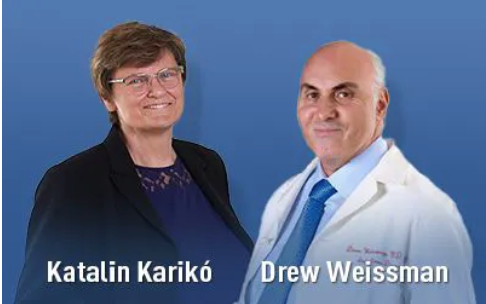News
Article
Nobel Prize Awarded to Scientists Whose Work Led to Development of mRNA COVID-19 Vaccines
Author(s):
Katalin Karikó, PhD, and Drew Weissman, MD, PhD, win Nobel Prize for discoveries in the area of nucleoside base modifications that enabled the development of effective mRNA vaccines against COVID-19.
This article was originally published by The American Journal of Managed Care.
Katalin Karikó, PhD, and Drew Weissman, MD, PhD, whose work together on the basic science of messenger RNA would later allow the development of mRNA vaccines so essential to containing the COVID-19 pandemic, today won the 2023 Nobel Prize in Physiology or Medicine.
Image Credit: The Nobel Prize

The announcement was made this morning in Stockholm, Sweden, home of the Nobel Assembly of the Karolinska Institutet. Karikó and Weissman, who did their work at the University of Pennsylvania, published their seminal paper in 2005 and were cited “for their discoveries concerning nucleoside base modifications that enabled the development of effective mRNA vaccines against COVID-19.”
Each will receive a Nobel Prize diploma and a Nobel gold medal, and they will split a monetary prize equivalent to about $989,000 in current exchange rates.
For Karikó in particular, receiving the Nobel Prize is a remarkable change of fortune 10 years after being “terminated" from her position at Penn, having never received tenure or funding from the National Institutes of Health, a well-known story she shared with Nobel Secretary General Thomas Perlmann. He told reporters that Karikó was very emotional when he reached her in a phone call prior to this morning’s announcement.
Karikó is now with the University of Szeged in her native Hungary, having left the University of Pennsylvania in early 2013 after seeing her opportunities to work on mRNA dwindle and learning that Moderna had signed a $240 million deal to develop a vascular endothelial growth factor mRNA. She later became a vice president at BioNTech RNA Pharmaceuticals, which developed an mRNA vaccine with Pfizer. Both the Moderna and Pfizer COVID-19 vaccines, which Nobel leaders say help prevent hospitalization as well as long COVID-19, were based on the work of Karikó and Weissman in the early 2000s.
Today, Kariko is also an adjunct professor at the University of Pennsylvania. Weissman remains active at Penn, where he is the Roberts Family Professor of Vaccine Research in the Perelman School of Medicine.
Rickard Sandberg, PhD, member of the Nobel committee, described the basic science behind the prize. For a century, vaccination strategies have focused on using weakened or inactive viruses to induce an antiviral response—this has been seen in polio and measles, for example. But advances in molecular biology have allowed specific genetic information from the virus to be used instead, with greater precision; the human papilloma virus vaccine is an example.
“Researchers have therefore long been attracted to the idea of using messenger RNA or mRNA for clinical applications,” Sandberg said. “The production of mRNA does not require large scale cell culturing, and future vaccines based on mRNA had the potential to become scalable, fast and flexible,” and major advances have been seen in recent decades.
But there were challenges with this approach. As Sandberg explained, “When in vitro produced mRNA was delivered into cells, it resulted in low protein amounts, and additionally, it triggered an inflammatory cytokine response.”
Karikó and Weissman, he said, brought together “highly complementary expertise,” she with a background in RNA biochemistry and a commitment to RNA therapeutics and he with a background in immunology.
The pair saw that in vitro mRNA was not the same as mRNA created in human cells; the in vitro mRNA was delivering the inflammatory cytokine response while the human mRNA was not, Sandberg said.
“Having explored several potential differences in the mRNA, they became interested in nucleoside based modification.” He explained how RNA has 4 “bases,” which can be chemically modified, with different results on tumor necrosis factor-α secretion depending on whether the mRNA was produced in vitro or in human cells. Kariko and Weissman were able to demonstrate these differences in a series of experiments, which they published in 2005; Sandberg noted this was 15 years before the pandemic.
“Karikó and Weissman made fundamental discoveries of the importance of base modifications in mRNA, which eliminated a major obstacle to mRNA-based clinical applications,” he said. This key discovery, as well as work by others on stabilized spike protein and mRNA delivery, meant “highly effective mRNA vaccines against COVID-19 were developed and approved in record time.”
For the underlying science of the mRNA vaccine to be awarded the Nobel Prize just 2 years after the vaccines were approved and used worldwide is breathtakingly fast by the committee’s standards. Typically, awards come years or even decades after the importance of the science is evident. At last year's Nobel press conference, when reporters peppered Perlmann with questions about why work on the mRNA science did not receive the prize, he gently admonished them, “That’s not how it works.”
But occasionally, the Nobel committee does cite a newsmaking winner in medicine: Today’s award comes 100 years after the citation for discovery of insulin, which came a year after the first patients were treated. And this morning, just before reading the announcement, Perlmann looked down and briefly smiled at the citation before breaking the news.
"The phrase Nobel Prize elicits images of individuals whose work has, without exaggeration, changed the world,” J. Larry Jameson, MD, PhD, executive vice president of the University of Pennsylvania for the Health System and dean of the Perelman School of Medicine, said in a statement. “During the biggest public health crisis of our lifetimes, vaccine developers relied upon the discoveries by Dr Weissman and Dr Karikó, which saved innumerable lives and paved a path out of the pandemic. Now, the same approach is being tested for other diseases and conditions. More than 15 years after their visionary laboratory partnership, Kati and Drew have made an everlasting imprint on medicine.”






